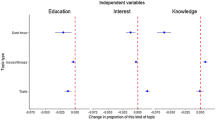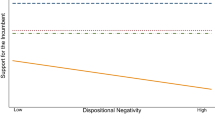Abstract
Results from a CATI survey of the 1993 Canadian federal election are presented. Response latencies to a voting intention question and a party identification question were obtained to measure the accessibility of these constructs among three groups of respondents: unconflicted partisans, who identified with a party and intended to vote for that party; conflicted partisans, who identified with a party but intended to vote for a different party; and nonpartisans. The voting intentions of unconflicted partisans and nonpartisans were expressed faster after the call of the election than before the election was called whereas those of conflicted partisans were expressed more slowly. Similarly, the party identification of unconflicted partisans was expressed faster after the call of the election whereas that of conflicted partisans was expressed more slowly. The implications of these and related results for the debate between proponents of the classical and revisionist views of party identification are discussed.
Similar content being viewed by others
References
Bassili, John N. (1993). Response latency versus certainty as indices of the strength of voting intentions in a CATI survey.Public Opinion Quarterly 57:54–61.
Bassili, John N. (1994a). Response latency and the accessibility of voting intentions: What contributes to accessibility and how it affects vote choice.Personality and Social Psychology Bulletin.
Bassili, John N. (1994b). The “how” and “why” of response latency measurement in survey research. In N. Schwarz and S. Sudman (eds.,Cognitive Processes in Surveys. New York: Springer/Verlag (in press).
Bassili, John N., and Joseph F. Fletcher (1991). Response-time measurement in survey research: A method for CATI and a new look at non-attitudes.Public Opinion Quarterly 55:331–346.
Brody, Richard A., and Lawrence S. Rothenberg (1988). The instability of partisanship: An analysis of the 1980 presidential election.British Journal of Political Science 18:445–466.
Campbell, Angus, G. Gurin, and Warren E. Miller (1954).The Voter Decides. Evanston, IL: Row, Pet.
Campbell, Angus, Philip Converse, Warren E. Miller, and Donald E. Stokes (1960).The American Voter. New York: Wiley.
Clause, Aage, R. (1966). Response validity: Vote report.Public Opinion Quarterly 32:588–606.
Converse, Philip E. (1964). The nature of belief systems in mass publics. (pp. 206–261). In David E. Apter (ed.),Ideology and Discontent. New York: The Free Press.
Converse, Philip E. (1966). The concept of a normal vote. In A. Campbell, P. Converse, W. Miller, and D. Stokes (eds.),Elections and the Political Order. New York: Wiley.
Converse, Philip E. (1970). Attitudes and non-attitudes: Continuation of a Dialogue (pp. 168–189). In Edward R. Tufte (ed.),The Quantitative Analysis of Social Problems. Reading, MA: Addison-Wesley.
Fazio, Russell H. (1990). A practical guide to the use of response latency in social psychological research (pp. 74–97). In C. Hendrick and M. S. Clark (ed.),Research Methods in Personality and Social Psychology, vol 11. Newbury Park: Sage.
Fazio, R. H. (1994). Attitudes as object-evaluation associations: Determinants, consequences, and correlates of attitude accessibility. In R. E. Petty and J. A. Krosnick (eds.),Attitude Strength: Antecedents and Consequences. Hillsdale, NJ: Erlbaum.
Fazio, Russell H., and Carol J. Williams (1986). Attitude accessibility as a moderator of the attitude-perception and attitude-behavior relations: An investigation of the 1984 presidential election.Journal of Personality and Social Psychology 51:505–514.
Fazio, Russell H., David M. Sanbonmatsu, Martha C. Powell, and Frank R. Kardes (1986). On the automatic activation of attitudes.Journal of Personality and Social Psychology 50:229–238.
Fiorina, Morris P. (1981).Retrospective Voting in American National Elections. New Haven, CT: Yale University Press.
Franklin, Charles H. (1992). Measurement and the dynamics of party identification.Political Behavior 14:297–309.
Franklin, Charles H., and John E. Jackson (1983). The dynamics of party identification.American Political Science Review 77:957–973.
Globe and Mail (1993). The TV debates had no decisive moments (p. 1). October 6.
Golbeerg, Arthur S. (1966). Discerning a causal pattern among data on voting behavior.Americal Political Science Review 60:913–922.
Graves, Frank, and Benoit Gauthier (1993). A mid-campaign report: The state of the nation before the debate. Ekos Research Associates.
Greenstein, Fred I. (1965).Children and Politics. New Haven, CT: Yale University Press.
Higgins, E. T. (1989). Knowledge accessibility and activation: Subjectivity and suffering from unconscious sources (pp. 75–123). In J. S. Uleman and J. A. Bargh (eds.),Unintended Thought. New York: Guilford Press.
Higgins, Tory E., G. A. King, and G. H. Mavin (1982). Individual construct accessibility and subjective impression and recall.Journal of Personality and Social Psychology 42:35–47.
Hyman, Herbert H. (1959).Political Socialization. Glencoe: Free Press.
Kenney, P. J., and T. W. Rice, (1988). Presidential prenomination preferences and candidate evaluations.American Political Science Review 82:1309–1319.
Kraut, Robert E., and John B. McConahay (1973). How being interviewed affects voting: An experiment.Public Opinion Quarterly 37:398–406.
Lau, Richard R. (1989). Construct accessibility and electoral choice.Political Behavior 11:5–32.
MacKuen, Michael B., Robert S. Erikson, and James A. Stimson (1989). Macropartisanship.American Political Science Review 83:1125–1142.
Markus, G. B., and P. E. Converse (1979). A dynamic simultaneous equation model of electoral choice.American Political Science Review 73:1055–1070.
Miller, Warren E. (1991). Party identification, realignment, and party voting: Back to the basics.American Political Science Review 85:557–568.
Petty, Richard, E. (1993).Attitude Ambivalence. Symposium held at the 101 st annual convention of the American Psychological Association, Toronto.
Schwarz, Norbert, and Seymour Sudman (eds.) (1992).Context Effects in Social and Psychological Research. New York: Springler-Verlag.
Srull, T. K., and R. S. Wyer, Jr. (1979). The role of category accessibility in the interpretation of information about persons: Some determinants and implications.Journal of Personality and Social Psychology 37:1660–1672.
Taylor, Shelley E., and Susan E. Fiske (1981). Getting inside the head: Methodologies for process analysis. In J. Harvey, W. Ickes, and R. Kidd (eds.),New Directions in Attribution Research, vol. 3. Hillsdale, NJ: Erlbaum.
Thompson, Megan M., Mark P. Zanna, and Dale W. Griffin (1994). Let's not be indifferent about (attitudinal) ambivalence. In R. E. Petty and J. A. Krosnick (eds.),Attitude Strength: Antecedents and Consequences. Hillsdale, NJ: Erlbaum.
Traugott, Michael W., and John P. Katosh (1979). Response validity in surveys of voting behavior.Public Opinion Quarterly 43:359–378.
Whiteley, Paul. F. (1988). The causal relationships between issues, candidate evaluations, party identification, and vote choice—the view from “Rolling Thunder.”Journal of Politics 50:961–984.
Zaller, John (1992).The Nature and Origins of Mass Opinion. Cambridge: Cambridge University Press.
Zaller, John, and Stanley Feldman (1992). A simple theory of the survey response: Answering questions versus revealing preferences.American Journal of Political Science 36:579–616.
Author information
Authors and Affiliations
Corresponding author
Rights and permissions
About this article
Cite this article
Bassili, J.N. On the psychological reality of party identification: Evidence from the accessibility of voting intentions and of partisan feelings. Polit Behav 17, 339–358 (1995). https://doi.org/10.1007/BF01498514
Issue Date:
DOI: https://doi.org/10.1007/BF01498514




